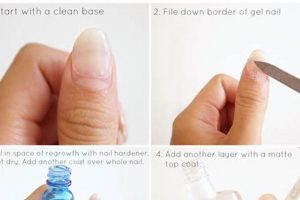The practice of creating personal lubricant from household ingredients is gaining attention. This involves combining readily available substances, often oils or water-based thickeners, to achieve a desired consistency and lubricity. An example would be blending aloe vera gel with distilled water to produce a moisturizing and easily accessible product.
The appeal of homemade lubricant stems from several factors, including cost savings compared to commercially manufactured options. It also allows individuals to control the ingredients, avoiding potential allergens or sensitivities found in store-bought varieties. Historically, individuals have relied on natural substances for lubrication, long before the mass production of specialized products.
This exploration will delve into the types of substances suitable for crafting these personal products, safety considerations regarding their preparation and application, and potential risks involved. Furthermore, information about maintaining hygiene during creation and storage will be provided, along with guidance on recognizing signs of adverse reactions that may necessitate discontinuing use.
DIY Lube
This section outlines crucial recommendations for those considering the creation and use of homemade personal lubricants. Adherence to these guidelines is paramount to minimizing risk and ensuring a safe experience.
Tip 1: Ingredient Research is Mandatory: Before combining any substances, thoroughly research each ingredient’s potential effects on the skin and mucous membranes. Confirm the absence of known irritants or allergens. Scientific literature, not anecdotal evidence, should inform this process.
Tip 2: Prioritize Hygiene During Preparation: Utilize clean utensils and containers when mixing ingredients. Bacteria can proliferate rapidly in homemade mixtures, increasing the risk of infection. Sterilization of equipment is highly recommended.
Tip 3: Conduct a Patch Test Before Widespread Application: Apply a small amount of the prepared lubricant to a discrete area of skin, such as the inner arm, and observe for 24-48 hours. Monitor for redness, itching, or swelling, indicating an adverse reaction.
Tip 4: Opt for Water-Based and Oil-Based Lubricants Separately: Do not combine oil-based and water-based ingredients unless explicitly verified as safe for mixing. Certain combinations can degrade the integrity of condoms or create a breeding ground for bacteria.
Tip 5: Avoid Sugary Substances: Refrain from incorporating sugar, honey, or similar ingredients. These can disrupt the vaginal pH balance and increase the likelihood of yeast infections.
Tip 6: Understand Expiration Dates: Homemade lubricants lack the preservatives found in commercial products and have a shorter shelf life. Discard any unused portion after a maximum of 48 hours, even if refrigerated. Note the date of creation clearly.
Tip 7: Recognize Signs of Infection: Discontinue use immediately and consult a healthcare professional if symptoms such as itching, burning, unusual discharge, or pain develop following application.
Following these precautions minimizes the potential for adverse reactions and helps ensure that experimentation with homemade personal lubricant remains a safe endeavor. However, individuals should always prioritize commercially available, FDA-approved products whenever possible.
The subsequent sections will explore specific ingredient types and their relative safety profiles in greater detail.
1. Ingredient safety
The viability of homemade personal lubricant hinges fundamentally on ingredient safety. An ill-considered selection of components can trigger adverse physiological reactions, negating any perceived benefits associated with the practice. The cause-and-effect relationship is direct: unsafe ingredients will, in all likelihood, produce negative health consequences. The importance of ingredient safety cannot be overstated; it represents the cornerstone of responsible experimentation. For example, using essential oils without proper dilution or understanding their individual properties can lead to significant irritation of sensitive tissues. Similarly, employing household products not intended for internal use exposes the body to potentially harmful chemicals.
Ingredient safety extends beyond simply avoiding known toxins. It necessitates a thorough understanding of pH levels and their impact on the delicate balance of the vaginal microbiome. Disrupting this balance can foster bacterial or fungal overgrowth, resulting in infections. Furthermore, certain ingredients, while seemingly innocuous, may degrade the integrity of latex condoms, rendering them ineffective. The practical significance of this understanding becomes apparent in the prevention of sexually transmitted infections and unintended pregnancies. For instance, oil-based substances, such as coconut oil, are known to compromise latex, emphasizing the need for water-based alternatives when using condoms.
In summary, the selection of safe and appropriate ingredients constitutes the most critical element in the creation of homemade lubricant. Challenges arise from the need for rigorous research, the potential for individual sensitivities, and the necessity of understanding complex chemical interactions. Nevertheless, prioritizing ingredient safety is paramount to minimizing risks and promoting a positive experience. Neglecting this aspect undermines the entire endeavor, potentially transforming a cost-saving or control-driven choice into a source of harm.
2. Preparation hygiene
Preparation hygiene, in the context of homemade lubricant creation, directly impacts the safety and usability of the final product. The absence of appropriate hygiene practices can introduce contaminants, leading to potential health complications and undermining the intended benefits.
- Sterilization of Equipment
The use of non-sterile equipment, such as mixing bowls, utensils, and storage containers, introduces microorganisms into the mixture. These microorganisms can proliferate, potentially leading to bacterial or fungal infections upon application. Sterilization, through boiling or the use of sanitizing agents, mitigates this risk. For example, improperly cleaned containers used for storing homemade lubricants have been shown to harbor harmful bacteria, rendering the product unsafe for use.
- Handwashing Practices
Hands serve as vectors for the transfer of microorganisms. Inadequate handwashing before and during the preparation process can introduce bacteria, viruses, or fungi into the lubricant. Implementing a rigorous handwashing protocol, including the use of antibacterial soap and proper technique, is crucial in minimizing contamination. An example includes contamination with fecal bacteria from hands, which then multiplies within the lubricant mixture, creating a high risk of i
nfection upon application. - Water Source Purity
If water is used as a component, its purity is paramount. Contaminated water sources can introduce harmful microorganisms or chemicals into the lubricant. Distilled or sterile water should be used exclusively to minimize these risks. Tap water often contains chlorine and other additives, and may harbor bacteria, rendering it unsuitable for this purpose. Failure to use purified water can lead to localized irritation or, in severe cases, systemic infection.
- Cleanliness of Workspace
The surrounding workspace must be clean to prevent environmental contamination. Dust, debris, and other particles can harbor microorganisms and introduce them into the preparation process. Regularly cleaning and sanitizing the workspace reduces the likelihood of contamination. A common example is the presence of mold spores in a damp or poorly ventilated workspace, which can then contaminate the ingredients and pose a health risk.
The confluence of these facets of preparation hygiene directly affects the safety and quality of homemade lubricants. While the allure of cost savings or ingredient control may be appealing, the potential risks associated with neglecting hygiene protocols must be carefully considered. Prioritizing cleanliness throughout the entire preparation process is essential for mitigating health risks and ensuring a product that is both safe and effective.
3. Patch testing
Patch testing serves as a critical safety measure when formulating homemade personal lubricants. The introduction of untested substances to sensitive mucosal tissues carries inherent risks of allergic reaction, irritation, or sensitization. Patch testing, therefore, acts as a preliminary screen to identify potential adverse responses before widespread application, mitigating the likelihood of more severe reactions. A direct cause-and-effect relationship exists: absence of patch testing increases the probability of experiencing an unanticipated negative reaction upon full application of the lubricant.
The standard procedure involves applying a small quantity of the newly created lubricant to a discrete area of skin, typically the inner arm or behind the ear. This area is then monitored over a 24-48 hour period for any signs of erythema, pruritus, edema, or other indications of inflammation. The observation period allows for the detection of both immediate and delayed hypersensitivity reactions. For example, an individual may exhibit no immediate response but develop significant itching and redness after 36 hours, signaling an incompatibility. Furthermore, patch testing allows for differentiating between irritant contact dermatitis, which is a direct toxic effect of the substance, and allergic contact dermatitis, an immune-mediated response. Understanding this distinction informs decisions regarding ingredient substitution or product discontinuation.
In summary, patch testing is an indispensable component of responsible homemade personal lubricant formulation. While it does not guarantee the absence of all adverse reactions, it significantly reduces the risk of severe complications. The practical significance of this practice lies in its ability to identify potential irritants or allergens before they cause significant harm, enabling informed decision-making and promoting safer experimentation. Challenges may arise in interpreting subtle reactions or addressing delayed hypersensitivity. However, prioritizing patch testing is essential for minimizing health risks and ensuring a positive experience with homemade lubricants.
4. Proper storage
The appropriate preservation of homemade personal lubricant is a crucial factor in maintaining its safety and efficacy. The absence of synthetic preservatives found in commercially manufactured products renders these mixtures more susceptible to degradation and microbial contamination, necessitating careful attention to storage protocols.
- Container Selection and Sanitization
The choice of container directly influences the risk of contamination. Opaque, airtight containers constructed from non-reactive materials, such as glass or certain plastics, are preferable. Thorough cleaning and sanitization of containers with boiling water or appropriate sterilizing agents are essential to eliminate pre-existing microorganisms. The practice of reusing containers without adequate sterilization can introduce pathogens that proliferate within the lubricant, posing a health hazard.
- Temperature Control and Environmental Factors
Elevated temperatures accelerate the degradation of organic compounds and promote microbial growth. Storing homemade lubricant in a cool, dark environment, ideally within a refrigerator, can significantly extend its shelf life. Exposure to direct sunlight or humidity can compromise the integrity of the mixture. For instance, a water-based lubricant stored at room temperature in a humid environment will exhibit a considerably shorter shelf life than one stored under refrigeration in a dry location.
- Prevention of Cross-Contamination
Implementing measures to prevent cross-contamination during storage is paramount. Separate storage locations for homemade lubricants and other personal care products minimize the risk of accidental contamination. Utensils used for dispensing the lubricant should be thoroughly cleaned before each use to avoid introducing bacteria or other contaminants. Shared containers or unsanitized applicators can serve as vectors for infection.
- Documentation of Preparation Date and Expiration
The creation date of the lubricant should be clearly marked on the container. Given the absence of preservatives, a conservative expiration date, typically within 48 hours of preparation, should be established. Discarding any unused portion after this timeframe, regardless of appearance or odor, mitigates the risk of using a contaminated product. Failure to track the preparation date increases the likelihood of inadvertently using expired lubricant, potentially leading to adverse reactions.
These factors, while seemingly discrete, converge to determine the overall safety and longevity of homemade personal lubricants. Addressing each aspect comprehensively is essential for mitigating the risks associated with microbial contamination and degradation. Furthermore, strict adherence to recommended storage protocols reinforces the importance of preparation hygiene and careful ingredient selection, reinforcing the overall safety profile of this practice.
5. Condom compatibility
Condom compatibility is a primary safety consideration when using homemade personal lubricants. The interaction between the lubricant’s constituents and the condom material significantly impacts the condom’s structural integrity and effectiveness as a barrier against sexually transmitted infections and unintended pregnancies.
- Oil-Based Lubricants and Latex Degradation
Oil-based substances, including coconut oil, olive oil, and mineral oil, are known to degrade latex condoms. The lipids in these oils weaken the latex polymer, increa
sing the risk of tearing or breakage during use. Studies have demonstrated a significant reduction in tensile strength of latex condoms exposed to oil-based lubricants within minutes. The use of oil-based homemade lubricants with latex condoms is, therefore, contraindicated. - Water-Based Lubricants and Condom Integrity
Water-based lubricants, formulated with ingredients such as glycerin, propylene glycol, or water-soluble polymers, are generally considered compatible with latex condoms. These lubricants do not typically compromise the integrity of the latex material. However, the specific formulation of the lubricant is crucial. Certain additives or preservatives may still have a detrimental effect. Researching the compatibility of each ingredient is necessary.
- Silicone-Based Lubricants as a Safe Alternative
Silicone-based lubricants represent a safe alternative for individuals using latex condoms. Silicone does not react with latex, preserving the condom’s strength and barrier function. However, silicone lubricants are not compatible with silicone-based sex toys, as they can degrade the toy’s surface. This interaction represents a distinct consideration separate from condom compatibility.
- Testing Lubricant Compatibility Prior to Use
A practical method for assessing compatibility involves applying a small amount of the homemade lubricant to a condom and stretching the material gently. Observing for any signs of weakening, discoloration, or increased elasticity indicates incompatibility. This test, while not definitive, provides a preliminary indication of potential issues. The absence of visible damage does not guarantee compatibility, highlighting the importance of using known-compatible lubricants whenever possible.
The intersection of homemade lubricant formulation and condom usage necessitates a thorough understanding of material interactions. While water-based options are generally considered safe for use with latex condoms, and silicone-based lubricants provide an alternative, careful ingredient selection and preliminary testing remain essential. The ultimate recommendation prioritizes commercially available, condom-compatible lubricants whenever possible, mitigating the inherent risks associated with untested homemade formulations.
6. Infection risks
The use of homemade personal lubricant introduces a spectrum of infection risks primarily stemming from the absence of standardized manufacturing processes, quality control measures, and effective preservatives commonly found in commercially produced alternatives. These risks are not negligible and necessitate careful consideration prior to engaging in the practice.
- Bacterial Contamination from Preparation
Homemade lubricants, prepared in non-sterile environments, are susceptible to bacterial contamination. Utensils, containers, or even airborne bacteria can be introduced during the mixing process. These bacteria can multiply rapidly, especially in the absence of preservatives, leading to potential infections upon application. An example would be the introduction of E. coli from inadequately washed hands or contaminated water sources, leading to urinary tract infections or vaginitis.
- Yeast Infections Due to pH Imbalance
The vaginal environment maintains a delicate pH balance. Certain ingredients commonly used in homemade lubricants, such as honey or sugar, can disrupt this balance, creating an environment conducive to yeast overgrowth. This imbalance can result in vulvovaginal candidiasis, characterized by itching, burning, and abnormal discharge. Furthermore, the lack of pH buffering agents in homemade formulations exacerbates this risk.
- Irritant Contact Dermatitis and Compromised Skin Barrier
Many ingredients utilized in homemade lubricants, including essential oils or undiluted acids, can cause irritant contact dermatitis. This inflammation damages the skin barrier, increasing susceptibility to infection. A compromised skin barrier allows opportunistic pathogens to colonize and invade, leading to localized or systemic infections. An example includes the use of concentrated citrus juices, which can cause severe irritation and increase vulnerability to bacterial invasion.
- Transmission of Sexually Transmitted Infections (STIs)
While lubricants generally facilitate safer sexual practices, homemade variants pose a unique risk. If an individual unknowingly has an STI, the use of homemade lubricant can potentially exacerbate the transmission risk. Ingredients might cause micro-abrasions, increasing viral shedding or bacterial spread. Unlike commercially available lubricants, homemade versions are not typically subjected to testing for microbial contamination. Therefore, using untested homemade personal lubricant may increase STI transmission risk.
These infection risks underscore the importance of meticulous hygiene, careful ingredient selection, and thorough risk assessment when considering homemade personal lubricant. While cost savings or ingredient control may be appealing, the potential health consequences associated with increased infection risk cannot be disregarded. Commercially manufactured lubricants, subject to rigorous quality control standards, generally represent a safer alternative, especially for individuals with compromised immune systems or a history of recurrent infections. The decision to use homemade lubricant should be made with informed awareness of the associated risks and a commitment to minimizing potential harm.
Frequently Asked Questions Regarding Homemade Lubricant
The following section addresses common inquiries and misconceptions surrounding the creation and utilization of “diy lube,” providing factual information to aid informed decision-making.
Question 1: Are all household oils safe for use as personal lubricant?
No. Certain household oils, such as mineral oil or baby oil, can degrade latex condoms, increasing the risk of breakage. Other oils may cause irritation or allergic reactions. Thorough research is essential before using any oil as personal lubricant.
Question 2: Can saliva serve as a safe alternative to commercial lubricant?
Saliva is not recommended as a lubricant. It lacks adequate lubrication properties and contains enzymes that can disrupt the vaginal pH balance, increasing the risk of infection. Additionally, saliva can transmit certain diseases.
Question 3: How long can homemade personal lubricant be stored before it expires?
Due to the absence of preservatives, homemade personal lubricant has a limited shelf life. It is recommended to discard any unused portion after a maximum of 48 hours, even when refrigerated, to minimize the risk of bacterial contamination.
Question 4: Is it safe to add essential oils to homemade personal lubricant?
Essential oils are highly concentrated and can cause severe irritation to sensitive tissues if not properly diluted. Many essential oils are not suitable for internal use. Extreme caution is advised, and thorough research is crucial before adding any essential oil to a homemade lubricant.
Question 5: Can homemade personal lubricant be used with all types of condoms?
No. Oil-based lubricants are incompatible with latex condoms. Water-based and silicone-based lubricants are generally safe for use with latex condoms, but the specific formulation should be verified to ensure compatibility. Silicon
e-based lubricants are incompatible with silicone-based sex toys.
Question 6: What are the signs of an adverse reaction to homemade personal lubricant?
Symptoms of an adverse reaction may include itching, burning, redness, swelling, or unusual discharge. Discontinue use immediately and consult a healthcare professional if any of these symptoms occur.
The safe creation and application of homemade lubricant necessitates scrupulous attention to ingredient selection, hygiene, and compatibility considerations. The risks associated with improper practices are significant and should not be underestimated.
The subsequent section will explore regulatory aspects and legal disclaimers relevant to the dissemination of information regarding DIY personal lubricants.
Conclusion
This exploration has presented various facets of creating personal lubricant from household ingredients. Key aspects discussed include ingredient safety, preparation hygiene, storage protocols, condom compatibility, and potential infection risks. The information outlined emphasizes the importance of rigorous research, careful execution, and a comprehensive understanding of potential adverse effects when engaging in the practice of making lubricant at home.
The complexities and inherent risks associated with DIY lube suggest a need for careful evaluation of potential benefits versus potential harm. Consumers should prioritize evidence-based practices and commercially available, regulated products whenever feasible. The information provided serves to promote informed decision-making, but does not constitute endorsement of DIY lube as a universally safe or preferable alternative to commercially available options. Individuals considering this practice should proceed with caution and consult with healthcare professionals as needed.


![DIY Build: Circular Saw Crosscut Jig PDF Plans [Free] The DIY Hub: Creative Crafts, Repairs & Life Hacks DIY Build: Circular Saw Crosscut Jig PDF Plans [Free] | The DIY Hub: Creative Crafts, Repairs & Life Hacks](https://craftingdiycenter.com/wp-content/uploads/2025/07/th-5916-300x200.jpg)


![Diya Aur Baati Hum: Illuminate Your Home [DIY Guide] The DIY Hub: Creative Crafts, Repairs & Life Hacks Diya Aur Baati Hum: Illuminate Your Home [DIY Guide] | The DIY Hub: Creative Crafts, Repairs & Life Hacks](https://craftingdiycenter.com/wp-content/uploads/2025/07/th-5913-300x200.jpg)

